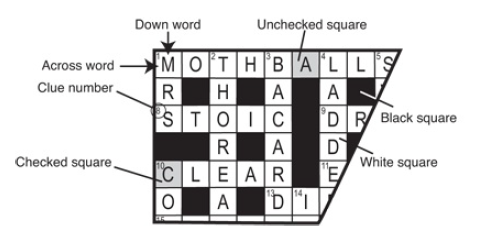Crossword Terminology
A few terms are good to know when discussing crosswords. I’ll start with the absolute basics, in case you’re not familiar with crosswords at all.
A crossword puzzle consists of a grid of black and white squares, some of which are numbered, and a set of clues placed near the grid. Crossword grids are usually an odd number of squares across and down — common grid sizes are 13 x 13 and 15 x 15.
Tiny clue numbers are placed in the corners of some of the squares, at the locations where a word starts. Once you’ve solved a clue, you write the answer into the grid, starting the word at the corresponding number on the grid. Answers can be entered either horizontally, called across entries, or vertically, called down entries.
So, for example, the answer to clue ‘8 across’ is written into the grid, with the first letter going in at the white square with the tiny ‘8’ in the corner, and the letters following subsequently across the grid. The clue numbers aren’t used for anything else; they simply connect the clue and its answer to the correct position in the grid.
Starting at the corresponding clue number, as with across clues, down clues are written into the grid, from top to bottom. The white squares of a grid are generally called just that — the white squares. The black squares can be called the darks, blanks, blocks or simply the black squares. In this book, I use the term black squares. A white square that’s part of both an across and a down word is said to be checked, keyed or crossed. A white square that’s part of just one word is unchecked, unkeyed or uncrossed (makes a crazy sort of sense!). In this book, I use the terms checked and unchecked. The next figure shows the basic elements of a crossword grid.

Some differences exist between the crossword styles popular in different countries. For example, American crossword grids are fully checked, with every white square in the grid being crossed by both an across and a down word. British grids have many more unchecked letters.
The clues for a crossword are usually printed in two columns, one for the across clues and one for the down clues. In cryptics (and many British-style quick, non-cryptic crosswords), the letter count is in brackets at the end of the clue, which tells you how many letters are in the answer. Of course, you can discover this information for yourself by counting the relevant squares in the grid. However, the letter count also tells you whether a hyphen is present in the answer, or the answer’s more than one word, which can be very helpful information. These quick clues illustrate these uses of the letter count:
Radiator additive (4-6) = ANTI-FREEZE Decorative legume (5,3) = SWEET PEA
After you have known the basics, you can start by trying “Crossword Daily: Word Puzzle” on your smart phone.

